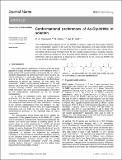Conformational preferences of Ac-Gly-NHMe in solution
Date
2015Metadata
Show full item recordAbstract
The conformational behaviour of Ac-Gly-NHMe in nonpolar, polar and polar protic solutions was systematically studied in this work by theoretical calculations and experimental infrared and 1H NMR spectroscopies. Ac-Gly-NHMe prefers a gauche conformer with a strong seven-membered intramolecular hydrogen bond for the isolated compound and in nonpolar solvents, but such preference changes in polar and polar protic solvents. Elucidation of Ac-Gly-NHMe preferences was also supported by studying the conformers of its CF3-C(O)-Gly-NHMe and Ac-Gly-N(Me)2 derivatives in solution.
Citation
Cormanich , R A , Rittner , R & Buehl , M 2015 , ' Conformational preferences of Ac-Gly-NHMe in solution ' , RSC Advances , vol. 5 , no. 16 , pp. 13052-13060 . https://doi.org/10.1039/C4RA16472E
Publication
RSC Advances
Status
Peer reviewed
ISSN
2046-2069Type
Journal article
Description
The authors thank a Grant # 2012/03933-5, São Paulo Research Foundation (FAPESP) for providing financial support for this research and a scholarship to RAC #2011/01170-1 (FAPESP). CNPq is also acknowledged, such as for fellowships (to RR) and a studentship (to RAC).Collections
Items in the St Andrews Research Repository are protected by copyright, with all rights reserved, unless otherwise indicated.

